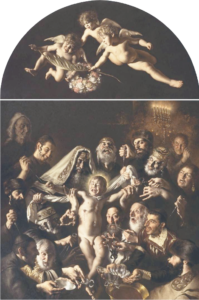The papal revolution fails
The mass of the clergy naturally knew that their power rested above all on the magic of the cause, on the beautiful appearance, on the outward and sensible charm of religious services; therefore they had to stand by the people, who venerated the sacred images.
______ 卐 ______
Editor’s note: This is a continuation of the pages on Byzantine iconoclasm. Religious art is propaganda and the lesson is clear. If you want the masses to change their paradigm, you have to destroy not only their Christian art, but their neochristian art as well (virtually all Hollywood movies, all American music and degenerate Western music of today, etc.). The burning of books should be as public as the Nazis did. But who among the so-called white nationalists thinks so radically? (a clue: they are still Judaeo-Christians or neochristians). Deschner continues:
______ 卐 ______
Gregory’s irritation wasn’t exclusively for theological reasons, but also very specific material reasons. Emperor Leo III successfully defended Constantinople by land and sea (717-718) against the Arabs in one of the most decisive slaughters in world history. And so Asia Minor, which gradually freed itself from Islamic rule in a series of annual campaigns, remained Byzantine and Christian for almost seven centuries. To balance its finances after the war against the Arabs, new taxes had to be imposed; this affected above all the Roman Church, which with its extensive territorial holdings was the leading economic power in Italy…
The monarch had an image of Christ replaced by a cross at the entrance to his palace. But Pope Gregory II was the real leader of Italy in the uprising against his lord, he was ‘the head of the Italian revolution’ (Hartmann). So ‘Be subject to authority’ no longer counted; what counted was ‘It is necessary to obey God rather than men’. And in practice God is always where the pope is! And the pope not only encouraged the patriarch of Constantinople, St Germanus, to fight against the emperor, but he called on the whole world, and so civil war broke out everywhere…
Consequently the exarch Paulus was ordered to depose Gregory from his papal chair. But when the Ravenna militia arrived, the pope opposed them with a league of Italian soldiers and Longboards. Imperial governors and officials were expelled from Venice, Ravenna and Rome, and Byzantine troops in Benevento and Spoleto. The exarch Paulus was eliminated by murderous hands. His generals were also eliminated. Doge Exhileratus and his son Adrian, excommunicated for years by the pope because of irregular marriage, were seized and killed by the Roman militia. The Roman doge Petrus had his eyes gouged out for having written to the emperor ‘against the pope’. The uprising triumphed everywhere: His Holiness and the Longboards rose in common rebellion against the emperor…
But the emperor eventually overpowered the rebellion. He seized all the pope’s patrimony in southern Italy, with Sicily alone representing a loss of 350 pounds of gold.
The dispute over images continued throughout Leo’s reign and became even more acute under his son and successor Constantine V (741-776), called Ikonokiastes, the destroyer of images (and also Kopronymos, for having soiled the water at his baptism, and Caballinus because he liked the smell of horse manure). It is true that when in 742 an iconodule usurper rose, his brother-in-law Artabasdos kept Rome on the side of the iconoclast emperor and had the eyes of the vanquished and his sons gouged out, and Pope Zacharias bequeathed a generous donation of land. Constantine, who took an active part in the long-standing dispute and who showed a remarkable interest in theological questions, had the invocation of the saints and Mary banned and all images of the saints removed or destroyed from the churches.
This emperor especially persecuted the monks, who were all the more fanatical supporters of the cult of images because they had an economic monopoly on the manufacture of icons. The monasteries were expropriated and closed, transformed into barracks and bathing facilities, or destroyed, as was the case with the monasteries of Kallistratos, Dios, Maximinos, and others. Their inhabitants had to choose between giving up their habits and taking wives or being blinded and banished. In Ephesus, nuns and monks were forced to marry and others were executed with the backing of a council held in Constantinople in 754…
The ‘blood and fire’ struggle culminated in the 760s. Abbot Stephanos of Mount Auxentius, leader of the iconodule opposition, was lynched in the streets of Constantinople in November 765. In August 766 alone, sixteen high-ranking officials and officers, supporters of the cult of images, were executed. The following year the head of the patriarch Constantine was also rolled into the palace. The emperor had already had him flogged…
Constantine, clean-shaven and wearing a derisory sleeveless dress, was led through the streets on a donkey to the hippodrome, where he was insulted and spat upon by the entire Christian populace. The donkey was led by the halter by his nephew Constantine, whose nose had been cut off. ‘When he arrived in front of the circus games, they came down from their seats, spat on him and threw filth at him. At the stop in front of the imperial tribune, they threw him off his horse and stepped on the back of his neck’. At the end of the month the man disavowed his belief, and after demanding reparation, he was beheaded. His corpse was dragged through the streets to the slaughterhouse of the executed and his head hung by the ears for three days as a public chastisement.
Isn’t this kind Christianity? Yes: that happened in Byzantium, but how were things in Rome?








